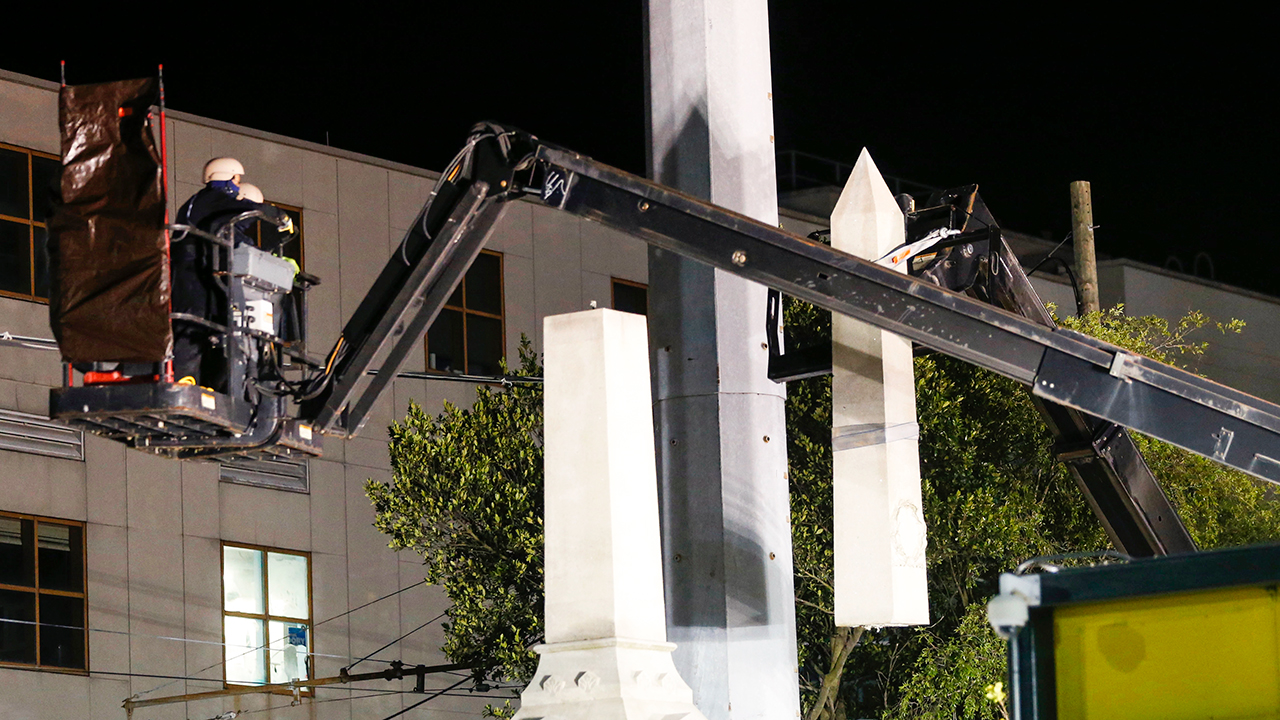Before the sun rose on Monday – a day celebrated in Alabama and Mississippi as Confederate Memorial Day – one of the monuments to white supremacy had fallen in the Deep South.
After more than a century on public property in New Orleans, The Liberty Monument was removed by construction workers clad in body armor and masks. The monument was erected to honor a bloody uprising in which members of the White League – a violent white supremacist militia – attempted to overthrow the Reconstruction-era government.
Despite the monument’s link to white supremacy, the prospect of its removal had enraged some people in the Crescent City, prompting death threats and requiring workers to don gear that was more suited for working a riot than removing a monument.
The Liberty Monument’s removal is the first of several such monuments that will be removed from public property by the city. Tributes to Confederate figures Robert E. Lee, Jefferson Davis and P.G.T. Beauregard are also slated for removal.
The SPLC has found that at least 60 such publicly funded symbols of the Confederacy have been removed or renamed since a white supremacist attempted to spark a race war in 2015 by killing nine black parishioners at a church in Charleston, South Carolina. After photos of the killer with the Confederate flag surfaced, communities began to re-evaluate the public display of Confederate symbols.
And there’s no shortage of such symbols.
In 2016, the SPLC documented more than 1,500 symbols of the Confederacy in public spaces as part of its report, Whose Heritage? The SPLC encouraged local governments to place the symbols in settings such as museums where people can learn the full history of the Confederacy.
The public debate – and the resistance to removal of these monuments – is far from over. In Mississippi, the only state where the Confederate battle flag is part of the state flag, some universities and cities have refused to fly the state flag until it is redesigned. Legislators have responded by considering a proposal that will force public institutions to display it.
In Georgia, plans to augment rather than remove the 3-acre Confederate Memorial Carving on Stone Mountain – once the site of KKK rallies – have stalled, despite being initially supported by Gov. Nathan Deal in 2015. Last year, Georgia also struck Confederate Memorial Day and Robert E. Lee’s birthday from the state’s holiday calendar. The days now bear the generic label of “State Holiday.”
At least one Georgia lawmaker has since introduced a resolution to recognize Confederate History Month and Confederate Memorial Day. Georgia Rep. Tommy Benton defended his proposal by invoking the election of Donald Trump.
“We just elected a president that said he was tired of political correctness,” said Benton. “And so that was the reason that we were looking to introduce the resolution.”
Benton is not the only political figure to cite Trump as the inspiration for such efforts. In Virginia, gubernatorial candidate Corey Stewart – Trump’s former campaign chairman for that state – tied his approval of Confederate symbols to Trump.
“[The Confederate flag] is a symbol of heritage. It is not a symbol of racism,” said Stewart. He added: “I think the 2016 presidential race was a watershed moment where you saw voters – including white voters and black voters and Asian voters and Hispanic voters – just fed up with political correctness and these gotcha techniques that the left has used to shut down speech.”
Stewart has gone so far as to compare efforts to dismantle Confederate symbols to the efforts of the Islamic State. In Alabama, the House of Representatives approved a bill this week that would make it more difficult for local governments to remove monuments, including Confederate monuments.
The removal of these monuments is not about erasing history. It’s about understanding our history and addressing the injustices of the past.

